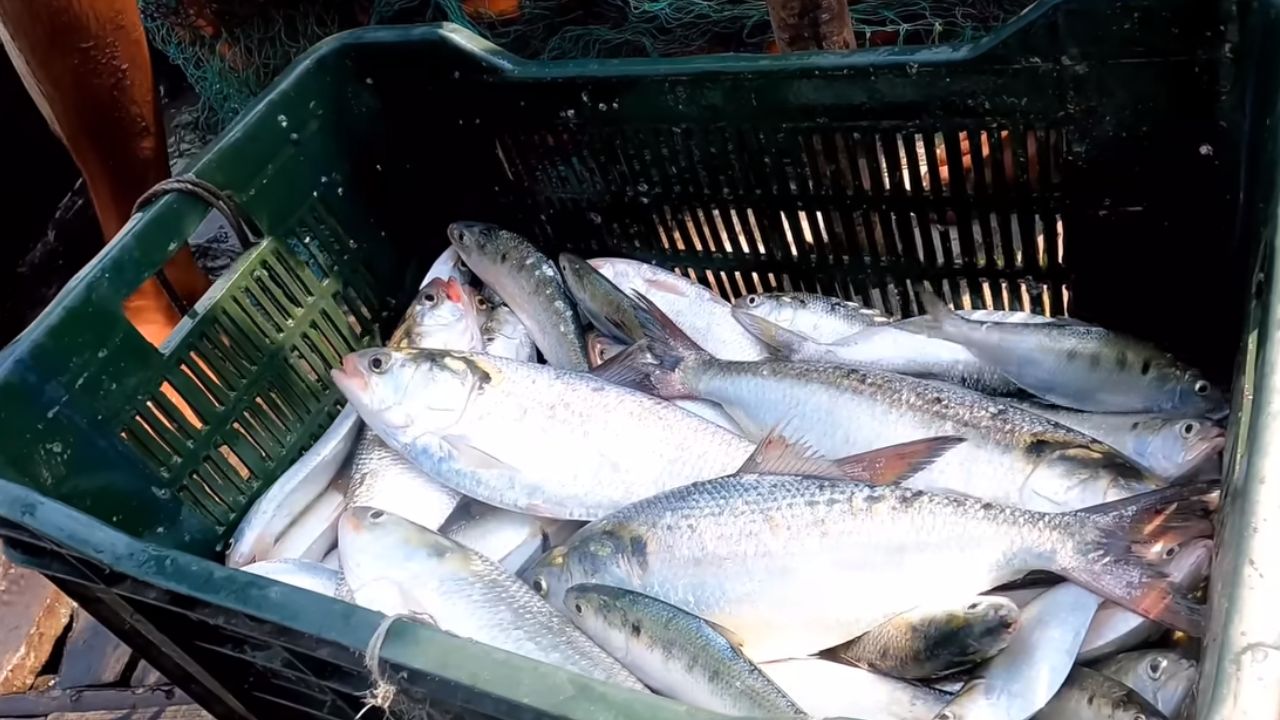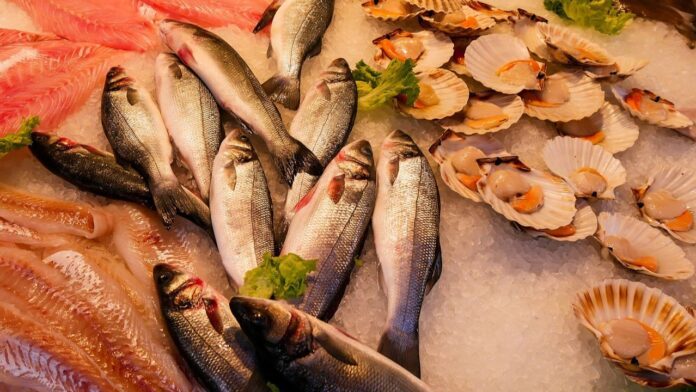In today’s article, we’re diving deep to explore the 20 nations where fish is more than just a menu item—it’s a way of life. We’re talking about Fish Consumption by Country Per Capita, and where seafood dishes are often considered national treasures. So, if you’re a seafood aficionado or simply curious about global eating habits, you’re in for a treat. Let’s get started!
According to the Food and Agriculture Organization (FAO) of the United Nations (UN), in recent decades, our appetite for aquatic foods has been growing faster than our global population. To put it in numbers, the consumption of seafood has been increasing at an average annual rate of 3%, while the world’s population has been growing at a slower pace of 1.6%. This surge in seafood consumption has been accompanied by a remarkable boost in global fish production. Between 1961 and 2017, fish production quadrupled, outpacing the doubling of the global population during the same period.
Read More: Countries With The Highest Coffee Consumption
This impressive increase in fish production can be attributed to ongoing innovations and the emergence of aquaculture over the past half-century. Aquaculture, sometimes referred to as fish farming or aquafarming, involves the cultivation of fish and other aquatic creatures in controlled environments, such as ponds or tanks. It has played a significant role in meeting the growing demand for seafood.
What’s particularly noteworthy is that the average per capita consumption of fish worldwide has also doubled during this time frame. This surge in consumption can largely be attributed to the higher yields achieved through aquaculture practices. In fact, aquaculture’s contribution to global fish production surpassed that of wild catch, which involves capturing fish and other seafood directly from their natural habitats like oceans, rivers, and lakes, in 2013.

In a nutshell, our love for seafood has been on the rise, and thanks to innovations and the growth of aquaculture, we’ve been able to keep up with this demand. This shift in how we source our fish, from primarily wild catch to a more controlled aquaculture approach, has been instrumental in maintaining a steady supply of delicious and nutritious seafood for the world’s tables.
Statistics on Seafood Consumption
The global appetite for seafood has seen quite a journey over the years, according to the Food and Agriculture Organization (FAO). Back in the 1960s, the average annual seafood consumption per person was a modest 9.9 kilograms (kg). Fast forward to 2019, and we hit a peak of 20.5 kg per capita. Looking ahead, it’s expected that by the end of this decade, the average person will be enjoying around 21.4 kg of fish and seafood each year.
When it comes to chowing down on fish, Asia takes the lead, gobbling up a whopping 72% of the world’s total fish production. If we narrow it down to individual countries, the Maldives, located in South Asia, holds the crown for the highest fish consumption per person as of 2020. Other seafood-loving places like Kiribati, Macao, and Hong Kong also rank among the top 5 countries in terms of fish consumption per capita worldwide.
Read Also: Countries with Highest Water Consumption in the World
Experts see a bright future for fish as a key player in ensuring food security, especially in coastal areas. Why the growing demand? Well, there are a few factors at play. Urbanization in coastal regions, improving household incomes, increased fish production, more efficient distribution channels, and a growing recognition of fish as a healthy and nutritious option all contribute to the surge in fish’s popularity.
In essence, seafood has come a long way in terms of global consumption, and it looks like it’s here to stay as a vital source of nutrition for many people, particularly those living by the sea.
Fishing Industry Economic Impact
The fishing industry isn’t just about catching fish; it’s a vital driver of economies worldwide and a significant source of employment. An impressive 58.5 million people have direct jobs in the fishing sector, while a staggering 600 million livelihoods depend in part on fisheries and aquaculture. In 2020, the global fish production reached an all-time high of 214 million tons, underscoring its immense contribution to the world’s food supply. Within this, aquaculture hit a record production level of 122.6 million tons, valued at a whopping $281.5 billion.
However, it’s important to note that the global trade of fishery and aquaculture products experienced a setback in 2020. The trade dipped to $151 billion, down from the 2018 figure of $165 billion. This decline was primarily due to COVID-19-related trade restrictions that disrupted global supply chains and impacted international trade.
Looking ahead, there’s a positive outlook for the industry. It’s projected that 89% of fish production will be intended for human consumption by 2030. Additionally, fish consumption levels are expected to rise by 18% by the end of this decade, compared to 2018 levels. These figures paint a rosy picture for the fishing industry, making it an attractive prospect for investors eyeing the best stocks in this sector.
You Can Read: Largest Exporters of Blueberries in the World
One prominent player in the global seafood market is Mowi ASA (MOWI.OL), a publicly listed company valued at $9 billion (NOK 99.26 billion). Mowi is renowned for its expertise in salmon farming and stands as one of the world’s largest producers of Atlantic salmon. They have operations spanning several countries, including Norway, Scotland, Canada, Ireland, and Chile. Notably, both Norway and Ireland feature on the list of countries with the highest fish consumption per capita in 2020.
Besides Mowi ASA (MOWI.OL), there are other promising aquaculture stocks worth considering. These include Aquabounty Technologies Inc (NASDAQ:AQB), Leroy Seafood Group ASA (OTCMKTS:LYSFF), and Bakkafrost P/F (OTCMKTS:BKFKF).
In essence, the fishing industry is more than a source of seafood; it’s a dynamic sector with significant economic impact and a promising future, making it an attractive arena for investors.
Our Approach
When it comes to identifying the countries with the highest per capita fish consumption, we turned to the extensive database offered by Our World in Data. This database serves as a valuable tool for gaining insights into global trends and statistics related to the fishing industry. To provide a clearer picture, we’ve ranked the top fish-consuming nations based on their 2020 consumption levels, starting from the lowest to the highest.
1. Maldives
Fish Consumption per capita: 87.30 kg
Total Population: 521,457
The Maldives, an enchanting archipelago nestled in the Indian Ocean, is celebrated for its unspoiled beaches and rich marine biodiversity. In the Maldives, fish holds a special place in their cuisine, being an absolute dietary staple. Among the various fish species savored in the Maldivian kitchen, skipjack tuna takes center stage. This versatile fish is a star ingredient in many beloved dishes, including mas huni—a traditional breakfast delicacy featuring shredded tuna, coconut, onions, and a touch of chili for a flavorful kick. Notably, in 2020, the Maldives proudly claimed the title of being the highest per capita fish-consuming country, a testament to the deep-rooted connection between its people and the bountiful ocean that surrounds them.
2. Iceland
Fish Consumption per capita: 84.30 kg
Total Population: 372,520
Iceland, an enchanting island nation renowned for its crystal-clear waters and rich marine wealth, boasts a thriving fishing industry and a longstanding heritage of savoring seafood. Cod takes the crown as the most beloved fish in Iceland, holding a prominent spot in Icelandic culinary traditions. This versatile fish finds its way into a wide array of dishes, including hearty classics like fish stews (known as plokkfiskur), the timeless favorite of fish and chips, and delightful preparations like pan-fried or grilled cod fillets. It’s safe to say that cod’s presence in Icelandic cuisine is as deep as the ocean waters that surround this picturesque island.
3. Macao
Fish Consumption per capita: 70.26 kg
Total Population: 686,607
Macao, celebrated for its captivating fusion of Chinese and Portuguese influences, boasts a culinary landscape as diverse as its cultural heritage, with a particular spotlight on seafood delicacies. Among the treasures of the sea, the white pomfret, a type of pomfret fish, enjoys widespread popularity in Macao. With its delectable flavor and versatility in various dishes, it has become a seafood staple in the region. In recognition of its hearty appetite for fish, Macao proudly claims the third spot on our list of countries with the highest per capita fish consumption.
4. Kiribati
Fish Consumption per capita: 69.22 kg
Total Population: 128,874
Kiribati, an idyllic Pacific island nation comprising 33 stunning coral atolls, boasts a vibrant fishing culture deeply intertwined with its way of life. For the people of Kiribati, seafood isn’t just a meal; it’s a vital source of sustenance. Among the treasures of the sea, trevally, a variety of jackfish, holds a special place in the hearts and palates of Kiribati locals. Its exquisite flavor and versatility in various dishes make it a cherished favorite among the island’s residents, reflecting the rich maritime heritage and reliance on seafood in this enchanting corner of the world.
5. Hong Kong
Fish Consumption per capita: 65.79 kg
Total Population: 7,413,100
Hong Kong, a Special Administrative Region (SAR) of China, boasts a vibrant culinary scene in which seafood takes center stage. Among the treasures of the sea, garoupa or grouper stands out as a highly prized delicacy in Hong Kong. This exquisite fish often finds itself on dinner tables steamed with ginger and scallions, a preparation that beautifully accentuates its natural flavors. Steamed garoupa with soy sauce is a signature dish served in numerous Cantonese seafood restaurants, reflecting the deep-rooted appreciation for seafood in Hong Kong’s cuisine. In 2020, Hong Kong’s per capita fish consumption reached an impressive 65.79 kg, underlining the city’s enduring love affair with seafood.
6. Portugal
Fish Consumption per capita: 59.36 kg
Total Population: 10,325,147
Portugal, with its extensive coastline and rich fishing traditions, holds a profound appreciation for fish and seafood. Among the culinary treasures, bacalhau, or salted cod, stands as an iconic symbol of Portuguese cuisine. This versatile fish undergoes a magical transformation, soaked and prepared in various delectable ways. From Bacalhau à Brás, a flavorful blend of shredded cod with potatoes, onions, and eggs, to Bacalhau com Natas, a creamy cod gratin, and the classic Bacalhau à Gomes de Sá, a comforting cod casserole adorned with onions, potatoes, and olives—Portugal’s love affair with bacalhau knows no bounds.
Beyond Portugal, our list of top fish-consuming nations includes the Maldives, Iceland, and Macao. The growing global demand for fish bodes well for some of the best fishing stocks, including notable names like Mowi ASA (MOWI.OL), Aquabounty Technologies Inc (NASDAQ:AQB), Leroy Seafood Group ASA (OTCMKTS:LYSFF), and Bakkafrost P/F (OTCMKTS:BKFKF). These stocks are riding the wave of increasing appetite for fish in these countries and beyond.
7. Antigua and Barbuda
Fish Consumption per capita: 57.12 kg
Total Population: 93,219
Antigua and Barbuda, nestled in the vibrant Caribbean, embrace a rich seafood culture, thanks to their idyllic coastal setting. Among the seafood delights cherished in the local cuisine, snapper takes a prominent place. Whether it’s the flavorful red snapper or the succulent yellowtail snapper, these fish varieties are beloved staples in Antiguan and Barbudan kitchens. The coastal charm of these islands is beautifully reflected in their culinary traditions, where the catch of the day often graces the tables in delicious preparations featuring these snapper treasures.
8. South Korea
Fish Consumption per capita: 54.66 kg
Total Population: 51,744,876
South Korea, blessed with an extensive coastline and teeming marine riches, boasts a vibrant seafood culture deeply embedded in its culinary traditions. Saengseon, also known as Pacific herring, takes center stage as a beloved fish in South Korean cuisine. This versatile fish finds its way into a plethora of delightful dishes, notably featuring in the creation of fish cakes known as eomuk. Saengseon also stars as a flavorful filling in a variety of dumplings and pancakes.
South Korea’s enduring love for seafood goes hand in hand with its position among the world’s top fish-consuming nations. The bounty of the sea plays a pivotal role in shaping the country’s diverse and delectable culinary landscape, celebrating the flavors of the ocean in countless ways.
9. Malaysia
Fish Consumption per capita: 53.33 kg
Total Population: 33,573,874
Malaysia, a captivating Southeast Asian nation celebrated for its rich tapestry of culinary traditions, holds a deep and abiding love for fish and seafood. Much like its neighbor Indonesia, Malaysia embraces the delectable Ikan Bakar, a dish loved by many. But that’s not all; another culinary gem that graces Malaysian tables is Assam Pedas, a flavorful and fiery fish stew. This aromatic delight comes to life with a blend of ingredients such as tamarind, chili, lemongrass, and a medley of spices. It’s typically prepared with fish varieties like mackerel (ikan kembung), catfish (ikan patin), or snapper (ikan merah), and served alongside steamed rice.
In Malaysia, the appreciation for fish and seafood runs deep, weaving a tale of culinary diversity and a harmonious fusion of flavors that captivate the taste buds and reflect the nation’s rich food heritage.
10. Seychelles
Fish Consumption per capita: 52.89 kg
Total Population: 99,258
Seychelles, holding the honorable tenth position on our list of countries with the highest per capita fish consumption, stands as a testament to its deep-seated connection to the sea. This breathtaking island nation is celebrated for its vibrant marine ecosystems and the delightful bounty of fresh seafood that graces its shores. In Seychellois cuisine, fish takes center stage, firmly establishing itself as an essential ingredient.
Among the stars of the sea, the red snapper shines brightly in Seychelles’ culinary repertoire. This beloved fish is not only a symbol of Seychellois seafood but is also celebrated for its versatility in the kitchen. Whether it’s grilled to perfection, delicately steamed, or given a delightful crispiness through frying, red snapper finds its way onto Seychellois plates in various tempting forms, showcasing the island’s culinary artistry and the flavors of the ocean.
11. Norway
Fish Consumption per capita: 50.57 kg
Total Population: 5,408,320
Norway, blessed with an extensive coastline and teeming cold, pristine waters, boasts a time-honored legacy of fishing and savoring seafood. In Norwegian culinary traditions, salmon takes the spotlight as one of the most beloved fish. Its popularity knows no bounds as it graces tables in various delightful forms.
From the enticing allure of smoked salmon, locally known as “røkt laks,” to the delicate perfection of gravlax, which is salmon cured to mouthwatering tenderness, and the simple pleasure of cooked salmon fillets, Norway knows how to showcase the versatility of this remarkable fish. Salmon is more than just a meal; it’s an integral part of Norwegian cuisine, often adorning plates as a sumptuous main course, tucked into sandwiches, or serving as a delectable topping for open-faced bread creations. Norway’s connection to the sea and its appreciation for the treasures it offers are beautifully reflected in the enduring popularity of salmon on Norwegian tables.
12. Micronesia
Fish Consumption per capita: 48.61 kg
Total Population: 113,131
Micronesia, a sprawling expanse of islands in the western Pacific Ocean, is home to a diverse array of nations and territories. Unsurprisingly, the local cuisine here boasts a strong connection to the ocean, thanks to its proximity to the vast waters that surround it. Fish and seafood are staples in Micronesian cooking, and among the many treasures of the sea, Mahi-Mahi, also known as dolphinfish, shines brightly.
Mahi-Mahi’s popularity in Micronesia lies in its versatility and delectable flavor. Whether it’s expertly grilled to bring out its smoky essence, gently baked to preserve its natural succulence, or pan-fried to a perfect crisp, Mahi-Mahi graces Micronesian tables in various mouthwatering forms. It often shares the spotlight with simple yet satisfying companions like rice or a medley of vibrant vegetables, creating a harmonious symphony of flavors that reflects the rich maritime heritage of Micronesia.
13. Japan
Fish Consumption per capita: 46.65 kg
Total Population: 125,681,593
Japan is renowned worldwide for its seafood-rich culinary traditions and profound reverence for fish. Among the treasures of the sea, bluefin tuna takes a place of honor, prized for its exceptional quality. It is the star of Japan’s sushi and sashimi, delighting palates with its exquisite taste and texture.
Hamachi, also known as Yellowtail, is another beloved fish in Japanese cuisine. Its versatility shines through in a variety of dishes, whether savored as sashimi, expertly grilled to perfection, or featured in sushi rolls. The delicate flavors of Hamachi are celebrated in Japanese culinary artistry.
Japan’s deep connection to the ocean is reflected in its impressive per capita consumption of fish, standing at 46.65 kg. While it may hold the thirteenth spot on our list of countries with the highest per capita fish consumption, Japan’s love affair with fish is anything but ordinary—it’s a culinary journey that showcases the country’s passion for seafood in every delectable bite.
14. Cambodia
Fish Consumption per capita: 46.65 kg
Total Population: 16,589,023
Cambodia, a charming Southeast Asian nation nestled in the southern part of the Indochinese Peninsula, boasts an abundance of waterways, including the mighty Mekong River and the sprawling Tonle Sap Lake. These aquatic riches have shaped Cambodia’s culinary landscape, making fish an indispensable ingredient in local cuisine.
One of Cambodia’s culinary treasures is Fish Amok, a dish that has achieved legendary status. This delectable creation reflects the nation’s deep connection to fish, combining it with a symphony of flavors and aromatic spices that are simply irresistible.
In 2020, Cambodia’s per capita fish consumption reached an impressive 46.65 kg. This figure speaks volumes about the integral role that fish plays in Cambodian food culture—a testament to the enduring love for seafood in this picturesque corner of Southeast Asia.
15. Myanmar
Fish Consumption per capita: 45.85 kg
Total Population: 53,798,084
Myanmar, situated in the heart of Southeast Asia, boasts a vibrant culinary tradition that embraces an array of delectable fish dishes. With its extensive coastline and a labyrinth of winding rivers, fish takes on a prominent role in the nation’s gastronomy.
At the heart of Myanmar’s culinary heritage is Mohinga, a dish that holds a special place as a national favorite. This flavorful creation is a testament to the country’s enduring love for fish, as it weaves together an intricate tapestry of flavors and textures that captivate the taste buds.
In terms of per capita fish consumption, Myanmar holds the fifteenth spot on our list, underlining the deep-rooted connection between the people of Myanmar and their appreciation for seafood. This culinary affair with fish continues to enrich the diverse and tantalizing flavors of Myanmar’s cuisine.
16. Nauru
Fish Consumption per capita: 44.75 kg
Total Population: 12,511
Nauru, a petite island nation nestled in the heart of the Central Pacific, faces challenges when it comes to fishing due to its limited land area and surrounding waters. Nevertheless, the people of Nauru have crafted their culinary traditions around the resources they have, making fish an essential ingredient in their cuisine.
One standout dish in Nauruan gastronomy is fish soup, celebrated for its simplicity and heartiness. Typically, this comforting meal features fish varieties like grouper or reef fish, simmered in a flavorful broth infused with vegetables, aromatic herbs, and a medley of spices. The result is a nourishing and satisfying dish that often finds its way to the dinner table, accompanied by bread or rice. In Nauru, the resourcefulness of its people shines through in their culinary creativity, allowing them to savor the flavors of the sea in a distinctive and delicious manner.
17. Indonesia
Fish Consumption per capita: 44.71 kg
Total Population: 273,753,191
Indonesia, an expansive archipelago blessed with abundant marine resources, boasts a stunning diversity of fish species that find their way into its vibrant cuisine. Among the culinary gems, grilled fish, locally referred to as Ikan Bakar, takes a prominent place in the hearts and palates of Indonesians. This beloved dish showcases the versatility of various fish varieties, including snapper, grouper, or mackerel, all of which are relished by residents across the archipelago.
In Indonesia, the love for seafood runs deep, and the rich marine resources that surround the nation play a pivotal role in shaping its diverse and flavorful culinary landscape. Grilled fish, with its smoky, succulent allure, reflects the country’s passionate embrace of the ocean’s bounty.
18. Samoa
Fish Consumption per capita: 43.97 kg
Total Population: 218,764
Samoa, a picturesque country nestled in the South Pacific Ocean, boasts a storied history that stretches back over 3,000 years. In this island paradise, grilling is not just a cooking method; it’s a cherished culinary tradition, especially when it comes to preparing fish.
The people of Samoa have perfected the art of grilling various fish types, including snapper, mahi-mahi, and trevally. Before hitting the open flame, these fish are treated to a delightful marinade, featuring a symphony of local herbs, aromatic spices, and zesty lime juice. The result is a tantalizing medley of flavors that captivates the taste buds.
Grilled fish in Samoa is more than just a meal; it’s a cultural celebration, often accompanied by staples like taro or breadfruit. This time-honored tradition reflects the deep connection between the Samoan people and the ocean that surrounds their beautiful homeland, creating a dining experience that’s both delicious and rich in heritage.
19. French Polynesia
Fish Consumption per capita: 43.95 kg
Total Population: 304,032
French Polynesia, a stunning collection of islands nestled in the South Pacific, boasts a cuisine deeply intertwined with the bounties of the sea. Seafood takes center stage in the local gastronomy, and among the cherished dishes, Poisson Cru stands out as a beloved tradition.
Poisson Cru, a time-honored delicacy, showcases the pristine flavors of the ocean. Typically featuring raw fish, often tuna or mahi-mahi, this dish undergoes a transformative journey as it’s marinated in zesty lime juice and luxuriously creamy coconut milk. The result is a refreshing and delightful medley of tastes and textures that pay homage to French Polynesia’s maritime heritage.
In French Polynesia, Poisson Cru is more than just a meal; it’s a culinary treasure, a celebration of the region’s abundant marine resources, and a testament to the islanders’ enduring connection to the sea.
20. Barbados
Fish Consumption per capita: 43.88 kg
Total Population: 281,200
Barbados, an enchanting Caribbean island nation celebrated for its pristine beaches and lively culture, thrives on a diverse economic landscape that includes tourism and offshore finance. Amid this vibrant backdrop, a culinary gem takes center stage—the flying fish, affectionately known as the flying cod.
This remarkable fish, with its daring leaps above the Caribbean waves, has earned the status of a national dish in Barbados. It graces tables in various delightful preparations, often accompanied by a side of cou-cou. This traditional Bajan dish is a harmonious blend of cornmeal and okra, serving as the perfect complement to the flying fish’s succulent flavors.
In Barbados, the love for this culinary pairing runs deep, reflecting both the island’s rich food culture and its close connection to the sea. It’s a flavorful celebration of the country’s heritage and a testament to the irresistible allure of the Caribbean’s culinary traditions.


















![10 Countries With the Best Healthcare in the World [Statistical Analysis] Countries With the Best Healthcare in the World](https://articleify.com/wp-content/uploads/2025/07/Countries-With-the-Best-Healthcare-in-the-World-1-150x150.jpg)










